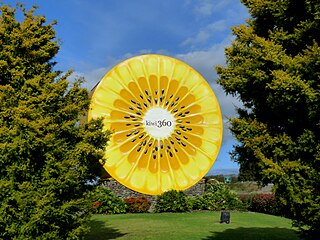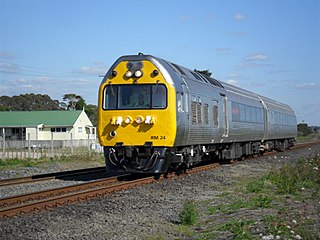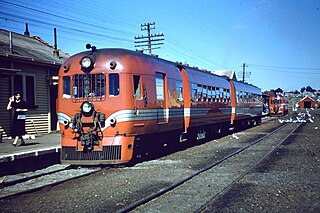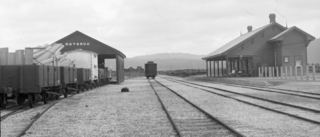Related Research Articles

Rail transport in New Zealand is an integral part of New Zealand's transport network, with a nationwide network of 4,375.5 km (2,718.8 mi) of track linking most major cities in the North and South Islands, connected by inter-island rail and road ferries. Rail transport in New Zealand has a particular focus on bulk freight exports and imports, with 19 million net tonnes moved by rail annually, with 99.5% of New Zealand's exports and imports being transported through the country's seaports.

Te Puke is a town located 28 kilometres southeast of Tauranga in the Western Bay of Plenty of New Zealand. It is particularly famous for the cultivation of kiwifruit.

The NZR RM class Silver Fern was a class of rail motor in New Zealand. The three air-conditioned and sound-proofed 723-kW 96-seater diesel-electric twin-set railcars were built by Kawasaki under contract with Nissho Iwai of Japan. New Zealand Railways (NZR) classified the railcars as RM , the same as other railcars, using the Silver Ferns because of their exterior was made of corrugated stainless steel, like the premier night sleeper train that also ran on the Wellington-Auckland route, the Silver Star. The Silver Ferns replaced the three successful Blue Streak railcars on the service.

The NZR RM class 88-seaters were a class of railcar used in New Zealand. New Zealand Government Railways (NZR) classified them as RM , the notation used for all railcars, numbering the 35 sets from RM100 to RM134. They were the most numerous railcars in NZR service. Their purchase and introduction saw the demise of steam-hauled provincial passenger trains and mixed trains, and was part of a deliberate effort to modernise NZR passenger services at a time of increasing competition from private motor vehicles. Being diesel powered and lighter the railcars were less expensive to operate and able to maintain quicker timetables, although became plagued with mechanical and electrical problems, with a number of the class eventually being turned into depowered locomotive-hauled carriages and reclassified as the AC class "Grassgrubs".
The Geyserland Express was a long distance passenger train operated by the Tranz Scenic division of Tranz Rail between Auckland and Rotorua in New Zealand's North Island. It utilised the Silver Fern railcars and operated from 9 December 1991 until 7 October 2001.
The Kaimai Express long-distance passenger train was operated by Tranz Rail under the Tranz Scenic brand between the North Island cities of Auckland and Tauranga via Hamilton. It used the Silver Fern railcars and operated from 9 December 1991 until 7 October 2001.

The RM class was the classification used by the New Zealand Railways Department (NZR) and its successors gave to most railcars and railbuses that have operated on New Zealand's national rail network. "RM" stands for Rail Motor which was the common name at the turn of the 20th century for what became known in New Zealand as railcars. As many types of railcars are operated, class names have been given to each railcar type to differentiate them from others.

The NZR RM class Sentinel-Cammell was a steam-powered railcar operated by the New Zealand Railways Department (NZR). It was the only one of its type to operate in New Zealand, and one of only two steam railcars trialled in the country; the other was the Clayton steam railcar.
The Thames Express was an express passenger train operated by the New Zealand Railways Department between Auckland and Thames. It ran between 1908 and 1928.

The East Coast Main Trunk (ECMT) is a railway line in the North Island of New Zealand, originally running between Hamilton and Taneatua via Tauranga, connecting the Waikato with the Bay of Plenty. The ECMT now runs between Hamilton and Kawerau, with a branch line to Taneatua from the junction at Hawkens. The line is built to narrow gauge of 1,067 mm, the uniform gauge in New Zealand. It was known as the East Coast Main Trunk Railway until 2011, when the word "Railway" was dropped.

The Goldfields Railway is a heritage railway that operates between Waihi and Waikino in the Bay of Plenty region of New Zealand's North Island. It operates over a section of track that was part of the East Coast Main Trunk Railway until the Kaimai Tunnel deviation made it redundant in 1978. The Goldfields Railway was formed in 1980 as the Goldfields Steam Train Society to retain a portion of the old mainline and switched to its current name in the mid-nineties.
The Palmerston North–Gisborne Line (PNGL) is a secondary main line railway in the North Island of New Zealand. It branches from the North Island Main Trunk at Palmerston North and runs east through the Manawatū Gorge to Woodville, where it meets the Wairarapa Line, and then proceeds to Hastings and Napier in Hawke's Bay before following the coast north to Gisborne. Construction began in 1872, but the entire line was not completed until 1942. The line crosses the runway of Gisborne Airport, one of the world's only railways to do so since Pakistan's Khyber Pass Railway closed.

The Kaimai Tunnel is a railway tunnel through the Kaimai Range in the North Island of New Zealand. Since it was opened in 1978, it has held the title of longest tunnel, at 9.025 kilometres (5.608 mi), in New Zealand, assuming this distinction from the previous title holder, the Rimutaka Tunnel. It is part of the Kaimai Deviation, which was constructed to bypass the old route of the East Coast Main Trunk Railway through the Karangahake Gorge.

The Rotorua Branch is a railway line from Putāruru to Rotorua, in the Waikato and Bay of Plenty regions of the North Island of New Zealand. Construction of the line was commenced by the Thames Valley and Rotorua Railway Company and finished by the Public Works Department (PWD). The complete line, 50.5 kilometres (31.4 mi) in length, opened in two sections; on 24 November 1893 to Tārukenga and the final 8 mi 43 ch (13.7 km) to Rotorua on 8 December 1894.

The Thames Branch railway line connected Thames, New Zealand, with Hamilton and was originally part of the East Coast Main Trunk railway. Part of the line between Morrinsville and Waitoa remains open and is in use as the Waitoa Branch line, connecting to the Fonterra Dairy Factory at Waitoa.
The Tāneatua Branch is a 25 kilometres (16 mi) long branch railway line in the Bay of Plenty, New Zealand, running from Hawkens Junction, west of Edgecumbe, to Tāneatua.
The Whakatane Board Mills Line of 10 km length was opened about 1939 as a freight only line, and was sometimes referred to as a "private siding".
The Paeroa-Pokeno railway line or deviation in the upper North Island of New Zealand between Paeroa on the East Coast Main Trunk (ECMT) and Pokeno on the North Island Main Trunk (NIMT) was a proposed route with construction started but abandoned. The proposal has been revived in recent years as part of a more direct route between Auckland and Tauranga.
The Paeroa railway station is a former railway station in Paeroa; on the Thames Branch, and on the East Coast Main Trunk Railway to Waihi.

The Great Journeys of New Zealand is the tourism division of KiwiRail that brings together its three Scenic train services with its passenger ferry business, Interislander. The new division was launched in May 2017 and replaced the former tourism brand KiwiRail Scenic Journeys. It has continuity with the earlier InterCity Rail (1987–1995) and Tranz Scenic (1995–2011).
References
Citations
- 1 2 Churchman & Hurst 2001, p. 115.
- 1 2 "East Coast Trains. Tauranga express to run". New Zealand Herald. 18 June 1928. Retrieved 25 July 2016.
- ↑ Brett & van der Weerden 2021, p. 114.
- ↑ "SPEED UP OF TANEATUA EXPRESS. TE PUKE TIMES". paperspast.natlib.govt.nz. 12 December 1950. Retrieved 30 July 2022.
- ↑ Brett & van der Weerden 2021, p. 179.
- ↑ T. A. McGavin (Spring 1967). "Railcars No More to Whangarei, Tauranga or Westport". New Zealand Railway Observer. New Zealand Railway and Locomotive Society. 24 (3): 88. ISSN 0028-8624.
- ↑ Brett & van der Weerden 2021, p. 253.
Bibliography
- Brett, André; van der Weerden, Sam (2021). Can't Get There From Here - New Zealand Passenger Rail Since 1920. Otago University Press. ISBN 9781990048098.
- Churchman, Geoffrey B; Hurst, Tony (2001) [1990, 1991]. The Railways of New Zealand: A Journey through History (Second ed.). Transpress New Zealand. ISBN 0-908876-20-3.